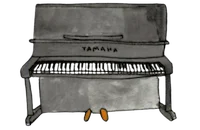Yamaha G1L Grand Piano
Yamaha will often make slight design changes to a piano and then release it again. To show these design changes they add a letter, but they are essentially the same piano, the Yamaha G1L reflects this. The Yamaha G1 and its variations are the smallest of the G range. They are made in Japan, and are perfect for the home or studio. Some G1L’s are quite old so check the condition carefully before buying. If you have any technical info or corrections for this article, please email mgpianos@gmail.com.
The pros of buying a Yamaha G1L
- As a compact piano, compared to other grand pianos, the Yamaha G1L is a wonderful option for those who want the beauty of a grand piano, but don’t have a large space.
- It has some very slight design changes over the G1, but is very similar in build, quality and musicality.
- It is built to last a life time and is made with the highest quality materials.
What are the cons of buying a Yamaha G1L?
- It has short bass strings, which means the sound quality is limited. A tall upright piano (U3, UX, etc) has longer bass strings than most baby grand pianos and they won’t take up as much space.
- It is an older model so take care to carefully check the condition.
- Don’t get bogged down in the added letters on the G1 variations. The G1, G1L and G1X are so similar you may struggle to spot the difference.
When was it produced?
The Yamaha G1 and its variations were produced between 1984 and 1994.
Where was it made?
Yamaha’s Hamamatsu factory in Japan is where the G1L was made, in fact all of Yamaha’s professional grade pianos are created here, including its concert grand, the CFX, which sells for £140k.
Videos
Quotes
Don’t just take my word for it, here is a quote I found on Piano World…
“I grew up playing one through high school until college, and it served me very well for a smaller grand piano while preparing auditions.” – http://forum.pianoworld.com/ubbthreads.php/topics/1599986/Yamaha_G1_who_knows_this_model.html
And another about the G1 (which is essentially the same piano)…
“I grew up playing a 1982 G1 through my teens, and it treated me well.” – http://forum.pianoworld.com/ubbthreads.php/topics/1374769/1980-yamaha-g1-worth-it-or-rx2-1980-1987.html
Who should buy them?
The Yamaha G1, or any of its variations, is a great choice for those who want the look and feel of a grand piano, but don’t have the space in their home. It won’t dominate the room too much and a G1L will be several thousand pounds cheaper than the later Yamaha C1. It wouldn’t be big enough to use in a recording studio or concert hall, for that you would be looking at a G3 or bigger.
Will I need to upgrade at some point?
If you can find a Yamaha G1L which has been well maintained, it should last you a lifetime. However, if you have a bigger space and budget, then you might want to upgrade to a G2 or G3 (or C2 / C3) to enjoy the touch and tone that you can only get from those longer models.
Dimensions
The Yamaha G1L is 146cm wide and has a length of 160cm
New and used prices.
A used Yamaha G1L will cost around £7000-£8500. The latest equivalent model (C1X) costs around £19,000 when bought new.
Alternative models to consider similar to this.
As mentioned before, the G1, G1L and G1X are all basically the same piano, so if you can’t find the G1L, then any of the others would make you just as happy. If you more room then the obvious alternative model to the Yamaha G1L would be the G2 or G3 as their extra length will provide a richer sound. If you want something newer, you should look towards the C1, C1L, and C1X which are more recent versions of the Yamaha G1. Finally, a full-sized upright piano (Yamaha U3, U30BL, UX, etc) has longer bass strings than most baby grand pianos, so perhaps consider an upright piano instead and try out those models.
Conclusion
The G1 and its variations are the perfect choice if space and budget is limited, but you really want a grand piano. Ensure you have it inspected before purchase, many people ignore that advice and take a gamble. Don’t do it.
Looking to buy?
To see our current stock list, click here.
Sign up to our email newsletter, and we will keep you updated.
I hope this summary was helpful to you, and as always your feedback, thoughts and questions are welcomed, so don’t hesitate to reach out.










